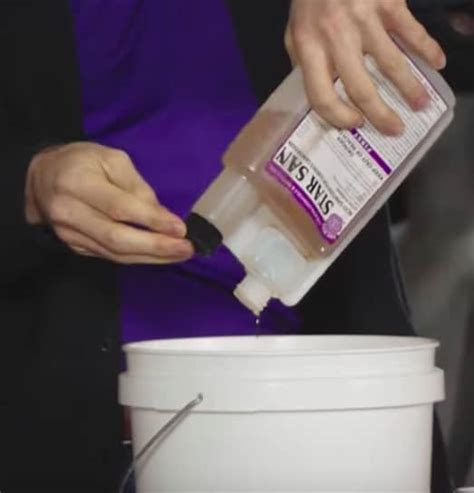How To Sanitize Mead Equipment
Ronan Farrow
Apr 02, 2025 · 3 min read

Table of Contents
How to Sanitize Mead Equipment: A Comprehensive Guide
Making mead is a rewarding process, but ensuring the quality and safety of your final product hinges on meticulous sanitation. Untreated equipment can harbor unwanted bacteria, wild yeasts, and other microorganisms that can ruin your batch, leading to off-flavors, spoilage, or even illness. This comprehensive guide will walk you through effective and safe ways to sanitize your meadmaking equipment.
Understanding the Importance of Sanitizing
Before diving into the methods, let's understand why sanitizing is crucial. Contamination from unclean equipment can lead to several problems:
- Off-Flavors: Bacteria and wild yeasts produce undesirable tastes and aromas, completely altering the intended flavor profile of your mead.
- Spoilage: Contamination can cause your mead to sour, become cloudy, or develop unpleasant sediments. This renders your hard work unusable.
- Infection: In severe cases, contaminated equipment can introduce harmful bacteria that cause illness if you consume the mead.
Therefore, sanitizing is not optional; it's an essential step in the meadmaking process.
Choosing Your Sanitizing Method: Star San vs. Other Options
Several methods exist for sanitizing mead equipment. Let's explore two popular choices:
Star San: The Popular Choice
Star San is a popular no-rinse sanitizer known for its effectiveness and ease of use. Its acidic nature makes it particularly effective against a wide range of microorganisms. The key advantage is that it doesn't require rinsing, saving you time and effort. Simply apply the solution, let it dwell, and then drain it off before using your equipment.
Key Considerations:
- Effectiveness: Highly effective against a broad spectrum of bacteria and yeasts.
- Ease of Use: No-rinse application simplifies the process.
- Cost: Relatively inexpensive compared to some other sanitizing solutions.
- Availability: Widely available online and at homebrew supply stores.
Other Sanitizing Options
While Star San is a favorite, other options are available:
- Iodine-based sanitizers: These are effective but require a thorough rinsing to avoid impacting the flavor of your mead.
- Sodium metabisulfite: This is another effective option but requires careful handling and proper dilution to avoid unpleasant tastes.
- Boiling: Boiling your equipment (if heat-resistant) can be an effective sanitizing method but may be impractical for certain items.
Always follow the manufacturer's instructions carefully for any sanitizer you choose.
Step-by-Step Sanitizing Process
No matter the sanitizer, follow these general steps for best results:
-
Cleaning: Thorough cleaning is the first step. Wash all your equipment with hot, soapy water. A bottle brush is invaluable for cleaning bottles and carboys. Pay close attention to crevices and seams where microorganisms might hide.
-
Rinsing: After washing, rinse thoroughly with clean, hot water to remove all traces of soap. Soap residue can interfere with the effectiveness of your sanitizer.
-
Sanitizing: Prepare your chosen sanitizer according to the manufacturer's instructions. Fully submerge or thoroughly coat all equipment with the solution, ensuring complete contact. Allow the recommended contact time – usually a few minutes. If rinsing is necessary, do so thoroughly with sterile water.
-
Air Drying: Let the equipment air dry in a clean, dust-free environment. Avoid using towels as they might introduce contamination.
-
Storage: Store sanitized equipment in a clean, protected place to prevent recontamination before use.
Equipment-Specific Sanitizing Tips
Certain equipment requires special attention:
- Bottles: Use a bottle brush to clean thoroughly and sanitize completely.
- Carboys: Sanitize the entire carboy, including the stopper and airlock.
- Fermenters: Pay close attention to the bottom and any crevices.
- Siphons and tubing: Sanitize completely and avoid touching the sanitized parts.
Maintaining Cleanliness: Preventing Contamination
Sanitizing is a crucial step, but preventative measures are just as important:
- Dedicated Equipment: Use equipment solely for meadmaking to minimize cross-contamination.
- Clean Workspace: Maintain a clean and organized workspace to reduce the risk of contamination.
- Regular Cleaning: Clean your equipment immediately after each use to prevent the buildup of residue and microorganisms.
By diligently following these steps, you can significantly reduce the risk of contamination and produce consistently high-quality mead. Remember, proper sanitization is an investment in the quality and safety of your mead-making endeavors!
Featured Posts
Also read the following articles
| Article Title | Date |
|---|---|
| How To Thaw Frozen Sewer Line | Apr 02, 2025 |
| How To Start A Gun Store | Apr 02, 2025 |
| How To Start A Valet Trash Service | Apr 02, 2025 |
| How To Subdivide Land In Nc | Apr 02, 2025 |
| How To Travel To Balabac Palawan | Apr 02, 2025 |
Latest Posts
-
P1df3 How To Fix
Apr 03, 2025
-
Mother Half Pipe This Is How I Roll
Apr 03, 2025
-
Mommed Pregnancy Test How Early
Apr 03, 2025
-
Mary Oliver How I Go To The Woods
Apr 03, 2025
-
Macon Controls Thermostat How To Use
Apr 03, 2025
Thank you for visiting our website which covers about How To Sanitize Mead Equipment . We hope the information provided has been useful to you. Feel free to contact us if you have any questions or need further assistance. See you next time and don't miss to bookmark.
